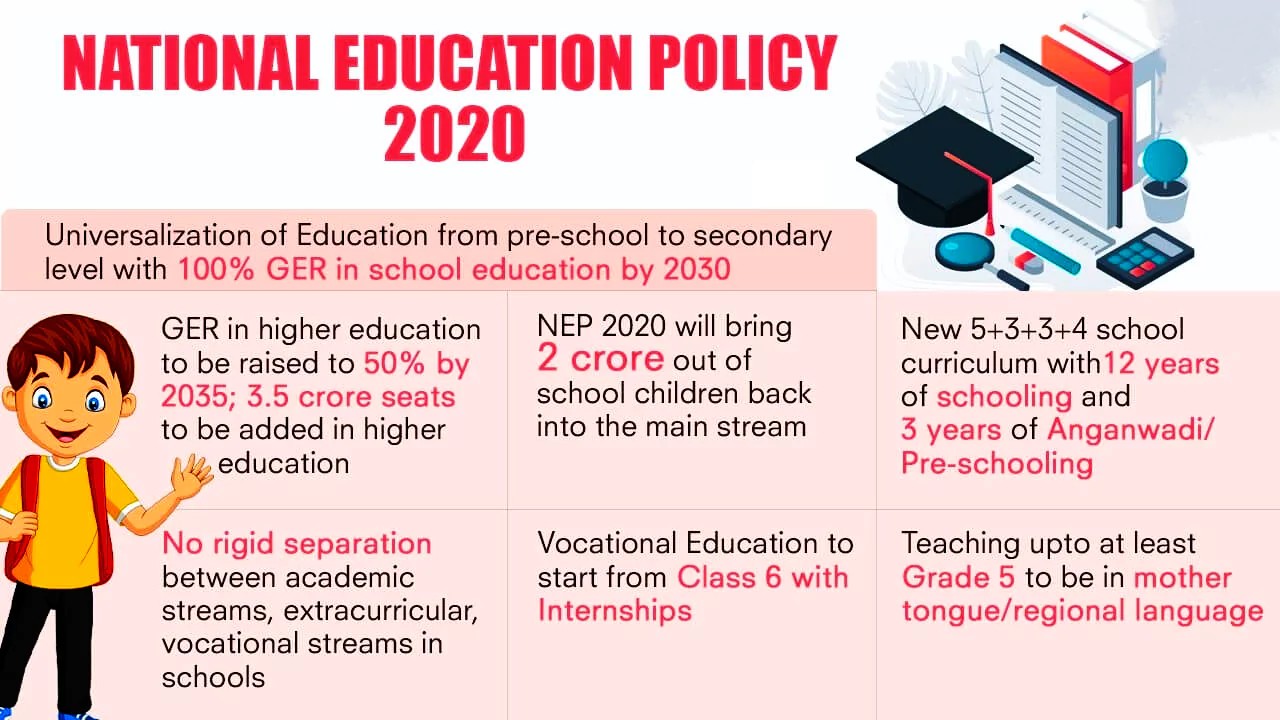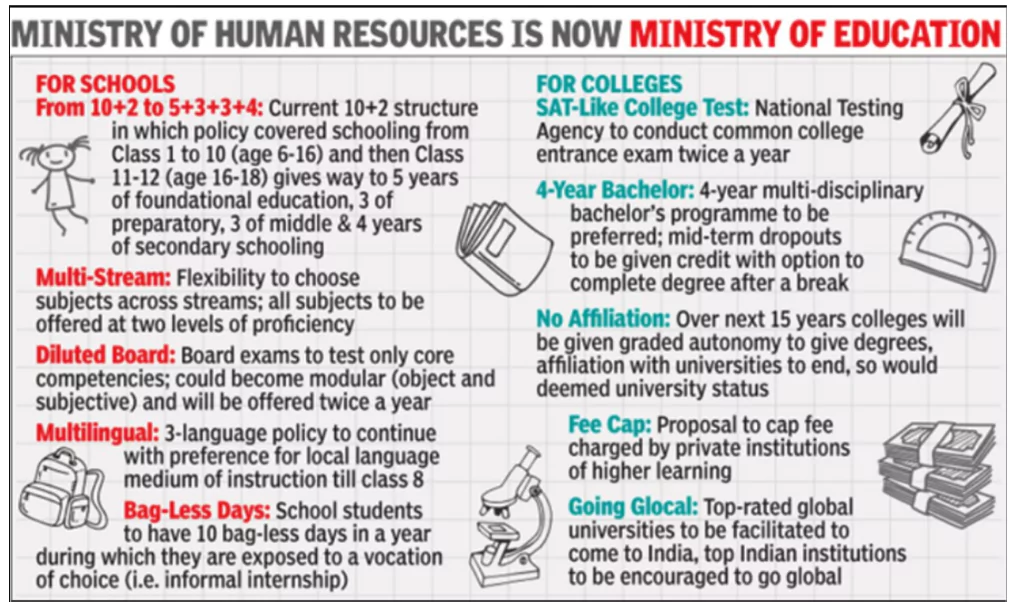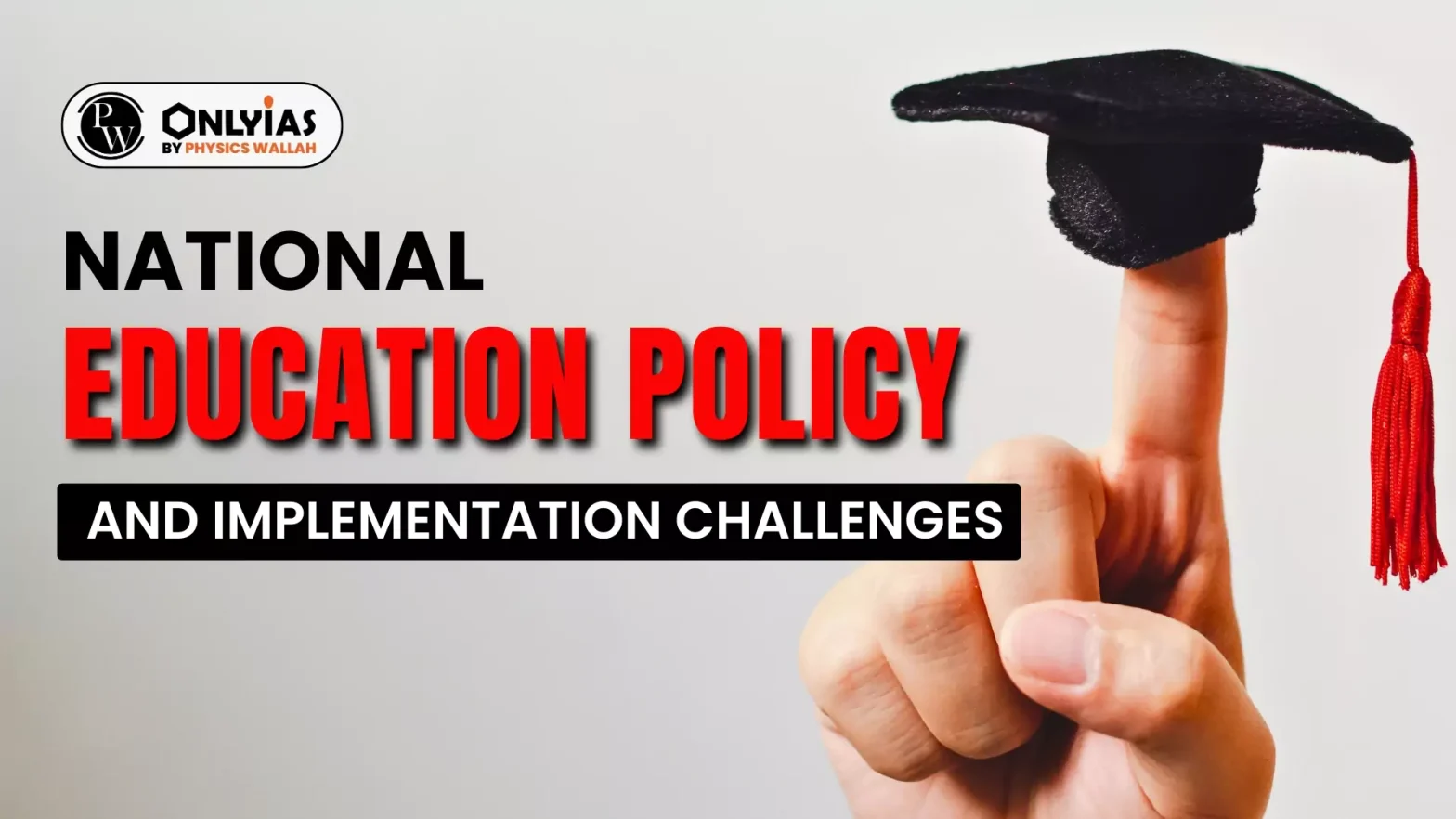The National Education Policy 2020 is a welcome and ambitious re-imagination of India’s education system into a modern, progressive and equitable one. However, it faces criticisms regarding its structure and content.
About National Education Policy 2020

- Background: The Ministry of Human Resource Development (MHRD) had constituted a Committee for drafting the new education policy (Chairman: Dr. K. Kasturirangan) in June 2017.
- The NEP replaces the National Policy on Education, 1986.
- The Central government’s National Education Policy (NEP), established in 2020, came into effect during the 2023- 2024 academic Year.
- Emphasis: The NEP 2020 lays particular emphasis on the development of the creative potential of each individual.
- Principle: The NEP is based on the principle that education must develop the foundational capacities of literacy and numeracy and higher-order cognitive capacities, such as critical thinking and problem solving and also social, ethical, and emotional capacities and dispositions.
Enroll now for UPSC Online Course
Various steps taken to Reform Education in India
- Radhakrishnan Committee
- Kothari Commission
- T.S.R. Subramanian Committee
- Kasturirangan Report (Drafted NEP)
|
Key Highlights of the National Education Policy 2020
- Holistic and Multidisciplinary Education: The NEP emphasises a shift from a rigid, compartmentalised education system to one that promotes holistic learning. The policy advocates the integration of arts, humanities, and sciences, encouraging students to explore diverse subjects and discover their passions.
- Early Childhood Care and Education (ECCE): The policy focuses on the crucial early years of a child’s development. It aims to provide a strong foundation for learning by integrating Early Childhood Care and Education into the formal education system. This will help enhance children’s cognitive, social, and emotional skills from an early age.
- Reimagining School Education: It aims to transform the current 10+2 schooling system into a more flexible 5+3+3+4 structure.
- The first five years will focus on foundational learning, followed by three years of preparatory education and four years of multidisciplinary secondary education.
- This approach aligns with global standards and promotes experiential learning and critical thinking.
 Multilingualism and Language Proficiency: Recognizing India’s linguistic diversity, the NEP encourages the teaching of regional languages along with Hindi and English. This move not only promotes cultural inclusivity but also aims to improve language proficiency and communication skills among students.
Multilingualism and Language Proficiency: Recognizing India’s linguistic diversity, the NEP encourages the teaching of regional languages along with Hindi and English. This move not only promotes cultural inclusivity but also aims to improve language proficiency and communication skills among students.- Assessment Reforms: The policy seeks to replace rote memorization with a competency-based approach to assessments. It encourages formative and continuous evaluations to gauge a student’s progress based on their understanding and problem-solving abilities rather than just marks.
- India’s first national assessment regulator PARAKH has been launched as part of the implementation of the NEP 2020 that will bring the much-needed uniformity in assessment.
- Promoting Digital Learning: With a focus on leveraging technology to improve access and quality of education, the NEP emphasizes the use of digital resources and e-learning platforms. This will help bridge the digital divide and ensure that students from all walks of life have equal access to educational opportunities.
- Higher Education Reforms: The NEP envisions a multidisciplinary and flexible higher education system. It aims to promote research and innovation, foster creativity, and establish robust connections between academia and industry. The policy also paves the way for foreign universities to set up campuses in India, promoting international collaboration.
- Teacher Empowerment: Recognizing the pivotal role of teachers in shaping young minds, the NEP aims to enhance teacher training and professional development. It also encourages a more learner-centric pedagogical approach and a greater emphasis on nurturing teachers’ creative and critical thinking skills.
- Gender and Social Inclusion: The NEP emphasises the importance of inclusivity, aiming to bridge gender and social gaps in education. It strives to ensure equal opportunities for all, regardless of gender, caste, or economic background.
- Greater Flexibility: Implementation of the Multi Entry and Multiple Exit (MEME) options within the framework of the NEP is a vital component of NEP 2020, offering students greater flexibility and choice in their educational pathways.
Check Out UPSC CSE Books From PW Store
Benefits of New Education Policy 2020
| For Students: |
For Teachers: |
- Holistic Development: NEP 2020 focuses on the holistic development of students, addressing their cognitive, social, emotional, and physical growth.
- It promotes critical thinking, creativity, and problem-solving skills, preparing students to thrive in the 21st century.
|
- Professional Development Opportunities: The new education policy recognizes the importance of continuous professional development for teachers.
- It provides opportunities for training, workshops, and collaborations to enhance their teaching skills, update their knowledge, and stay abreast of evolving pedagogical practices.
|
- Flexible Learning Pathways: The policy offers flexible learning pathways, allowing students to choose subjects based on their interests and career aspirations.
- This promotes personalised learning, enabling students to explore their passions and develop expertise in their chosen fields.
|
- Enhanced Teaching Practices: The policy encourages a shift towards learner-centric teaching practices, promoting interactive and experiential learning methods.
- This allows teachers to engage students actively in the learning process, fostering deeper understanding and retention of concepts.
|
- Reduced Curriculum Burden: NEP aims to reduce the curriculum burden on students by emphasising core concepts and essential learning outcomes.
- This allows for a deeper understanding of subjects and encourages a more comprehensive learning experience.
|
- Integration of Technology: Teachers can leverage digital tools, online resources, and educational apps to enhance their teaching effectiveness, create interactive learning experiences, and cater to diverse learning styles.
|
- Inclusive Education: The policy prioritises inclusive education, ensuring equal opportunities for students from diverse backgrounds, including those with disabilities and from marginalised communities.
- It promotes an inclusive and supportive learning environment, fostering empathy and understanding among students.
|
- Recognition of Leadership and Mentorship: It also recognizes the importance of teacher leadership and mentorship.
- Teachers have the opportunity to take on mentoring roles, supporting their fellow educators, and contributing to policy implementation. This fosters professional growth and collaboration among teachers.
|
- Skill Development: NEP 2020 emphasises skill development, equipping students with 21st-century skills such as critical thinking, communication, problem-solving, and digital literacy.
- This enhances their employability and prepares them for future challenges.
|
- Collaborative Learning Communities: NEP also promotes collaborative learning communities that creates a supportive environment for professional growth and enhances teaching effectiveness.
- The policy empowers teachers to become facilitators of learning rather than just information providers.
- They can guide students through their learning journey, foster critical thinking, and nurture students’ interests and talents.
|
Issues with National Education Policy 2020
- Standardised Interoperable & Mobility-based Higher Education Ecosystem: The credit-based eight-semester format seeks to create this ecosystem, where students can transfer their credits theoretically anywhere, impacting engagement in meaningful academic work.
- Education is a function of reception and reciprocation, of learning, absorbing, evaluating and responding critically. However, this reimagining of higher education seems like education as a means to survive in the marketplace, with a huge price attached to it.
- Truncation of Syllabus: As a result of the credit-based system (where the structure determines the content and not vice versa, as it ought to be) syllabi in all disciplines have been stunted.
- Example: Even the chapters prescribed have been truncated in many instances.
- A poem by Walt Whitman named ‘Passage to India’ has 255 lines across 13 sections. Under the NEP syllabus, just 68 lines across 4 sections have been prescribed. However, it is a philosophical poem that needs to be understood in its entirety.
- Dilution of Core Syllabus: The bigger problem with NEP pedagogy is the dilution of the core subject, impacting the gain of specialised knowledge.
- By diluting the core content of the subject, NEP is causing the lowering of standards in domain-centric knowledge dispensation and absorption.
- Example: For Economics Honours in the St Xavier’s University, Kolkata, only one out of eight courses directly relate to the honours subject, while the rest cover various other areas of specialised knowledge such as human behaviour and media studies.
- Assessment Burden on Students: Under the NEP, students are required to take seven to eight exams per semester with many internal assessments.
- This, combined with marks for attendance separately and for continuous assessment classes attended, creates a huge bureaucratic load (both for students and teachers).
- Practical Exams in Arts Subjects: Under NEP, practicals were prescribed for even non-core Arts subjects, which is impractical.
- However, after facing the impracticalities of conducting practical exams for non-core subjects, Delhi University recently removed it.
- Implementation and Resource Allocation: Issues like lack of infrastructure, inadequate funding, and shortage of trained teachers need to be addressed to ensure the policy’s success.
- Digital Divide: While the policy emphasises the use of technology in education, the existing digital divide, particularly in rural areas and among socio-economically disadvantaged groups, may hinder the equitable implementation of technology-driven learning solutions.
- Monitoring and Evaluation: The NEP 2020 lacks a clear monitoring and evaluation mechanism to assess its progress towards achieving SDG-4.
Check Out UPSC NCERT Textbooks From PW Store
| Sustainable Development Goal 4 is about quality education. The full title of SDG 4 is “Ensure inclusive and equitable quality education and promote lifelong learning opportunities for all”. |
- Multiple Entry And Multiple Exit (MEME): Indian institutions are likely to face several issues in implementing the MEME system under the new education policy.
- According to the report, while the MEME looked like a flexible system, which was being operated by Western educational institutions effectively, it might not work well in the country.
- Role of State & Accessibility: Rashtriya Uchchatar Shiksha Abhiyan (RUSA) Scheme aims to provide strategic funding to eligible state higher educational institutions. Strategic funding to higher educational institutions based on critical appraisal of State’s plans.
- Limited access to higher education in socio-economically disadvantaged areas due to financial barriers, geographical constraints, stereotype threat faced by students of marginalised sections etc.
- Linguistic Issues: Most of the HEIs primarily use English as a medium of instruction and there is a lack of HEIs that teach in local languages. This leads to exclusion of non-english speakers, cultural and regional disconnect, and exacerbation of economic disparities.
- Lack of Funding: Public investment in the Education sector needs to reach 6% of GDP at the earliest. According to the Economic Survey 2022-23, total education outlay added up to 2.9% of the GDP.
- There is scope for India as well to increase its budgetary allocation in education from a mere 2.9% of its GDP to 6%.
Major Initiatives under National Education Policy 2020
- PM Schools for Rising India (SHRI) to provide high-quality, equitable, and joyful education in schools.
- NIPUN Bharat to ensure universal foundational literacy and numeracy by the end of Grade 3 by 2026-27.
- PM e-VIDYA to promote online education and digital learning through platforms like DIKSHA and offering e-books and content to students.
- National Curriculum Framework for Foundational Stage and Jadui Pitara for play-based learning for children aged 3 to 8 years.
- NISHTHA for capacity-building programs for teachers and school principals in India.
- National Digital Education Architecture (NDEAR) blueprint for digital technology-based education applications.
- Introduction of Various Academic Frameworks such as National Credit Framework and National Higher Education Qualification Framework to facilitate credit transfer and academic flexibility.
- World-Class Institutions Scheme to create affordable, top-notch academic and research facilities, designating “Institutions of Eminence”.
- Global Initiative of Academic Networks (GIAN) aimed at tapping the talent pool of scientists and entrepreneurs, internationally to encourage their engagement with the institutes of Higher Education in India so as to augment the country’s existing academic resources, accelerate the pace of quality reform, and elevate India’s scientific and technological capacity to global excellence.
- The Scheme for Promotion of Academic and Research Collaboration (SPARC) aims at improving the research ecosystem of India’s Higher Educational Institutions by facilitating academic and research collaborations between Indian Institutions and the best institutions in the world from 28 selected nations to jointly solve problems of national and/or international relevance.
|
Conclusion
While the NEP 2020 aims to bring about positive transformations in the Indian education system, it is essential to critically evaluate its pros and cons. Stakeholder input is crucial for meaningful reforms in education. To improve NEP, there is a need to reassess its credit-based system, emphasising core subjects and eliminating non-core courses.
Enroll now for UPSC Online Classes
![]() 18 Jun 2024
18 Jun 2024


 Multilingualism and Language Proficiency: Recognizing India’s linguistic diversity, the NEP encourages the teaching of regional languages along with Hindi and English. This move not only promotes cultural inclusivity but also aims to improve language proficiency and communication skills among students.
Multilingualism and Language Proficiency: Recognizing India’s linguistic diversity, the NEP encourages the teaching of regional languages along with Hindi and English. This move not only promotes cultural inclusivity but also aims to improve language proficiency and communication skills among students.